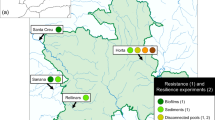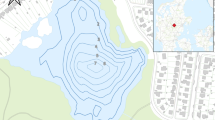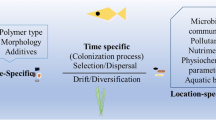Abstract
The effects of freshwater infaunal invertebrates on sediment geochemical properties were studied through an experimental approach using indoor microcosms during a 56-day experiment. The bioturbating organisms were tubificid worms, which consume sediment at depth and deposit undigested material at the sediment–water interface. Bioturbation intensity was determined using fluorescent tracers, and the distribution of redox-sensitive compounds was studied from replicate experimental units handled 7, 14, 21, 28 and 56 days after tubificid colonization. Worm activity transferred reduced particles and pore water at the sediment surface at a rate of 0.14 cm day−1. Compared to control experimental units, this recycled material represented at the end a several centimetre-thick layer enriched in water content, dissolved nitrate and sulphate, and depleted in oxygen, ammonium and dissolved Mn(II). Tubificids consumed O2 in bottom water, so that the sediment was anoxic, allowing a direct flux of dissolved reduced species into overlying water. Lower ammonium and Mn(II) concentrations and fluxes in anoxic sediment possibly resulted from a decrease in anaerobic microbial metabolism due to competition for labile organic carbon with tubificids. Higher sulphate concentration resulted from burial of surface waters with particle at the sediment surface, but not from bio-irrigation of burrows. Nitrate was produced in anoxic condition, as observed in almost every mixed modern sediments.










Similar content being viewed by others
References
Aller RC (1982) The effects of macrobenthos on chemical properties of marine sediment and overlying water. In: McGall PL, Tevesz MJS (eds) Animal-sediment relations. Plenum, New York
Aller RC (1994) Bioturbation and remineralization of sedimentary organic matter: effects of redox oscillations. Chem Geol 114:331–345
Anderson L (1979) Simultaneous spectrophotometric determination of nitrite and nitrate by flow injection analysis. Anal Chim Acta 110:123–128
Anschutz P, Sundby B, Lefrançois L, Luther GWI, Mucci A (2000) Interaction between metal oxides and nitrogen and iodine in bioturbated marine sediments. Geochim Cosmochim Acta 64:2751–2763
Anschutz P, Jorissen FJ, Chaillou G, Abu-Zied R, Fontanier C (2002) Recent turbidite deposition in the eastern Atlantic: early diagenesis and biotic recovery. J Mar Res 60:835–854
Berner RA (1980) Early diagenesis: a theoretical approach. Princeton University Press, Princeton
Blackburn TH (1988) Benthic mineralization and bacterial production. In: Blackburn TH, Sorensen J (eds) Nitrogen cycling in coastal marine environments. Scope, Chichester, pp 175–190
Boudreau BP (1996) The diffusive tortuosity of fine-grained unlithified sediments. Geochim Cosmochim Acta 60:3139–3142
Boudreau BP (1997) Diagenetic models and their implementation. Springer, Berlin
Boudreau BP (1999) Metals and models: diagenetic modelling in freshwater lacustrine sediments. J Paleolimn 22:227–251
Braeckman U, Provoost P, Gribsholt B, Van Gansbeke D, Middelburg JJ, Soetaert K, Vincx M, Vanaverbeke J (2010) Role of macrofauna functional traits and density in biogeochemical fluxes and bioturbation. Mar Ecol Prog Ser 399:173–186
Brendel PJ, Luther GW (1995) Development of a gold amalgam voltammetric microelectrode for the determination of dissolved Fe, Mn, O2, and S(-II) in porewaters of marine and fresh-water sediments. Environ Sci Technol 29:751–761
Burdige DJ (1993) The biogeochemistry of manganese and iron reduction in marine sediment. Earth Sci Rev 35:249–284
Chaillou G, Anschutz P, Dubrulle C, Lecroart P (2007) Experimental study of transient diagenesis in modern turbidites. Aquat Geochem 13:157–172
Ciutat A, Anschutz P, Gerino M, Boudou A (2005) Bioturbation effects by tubificids worms on cadmium transfers from the water column to the sediment compartment. Environ Toxicol Chem 24:1048–1058
Ciutat A, Weber O, Gerino M, Boudou A (2006) Stratigraphic effects of tubificids in freshwater sediments: a kinetic study based on X-ray images and grain-size analysis. Acta Oecol 30:228–237
Ciutat A, Gerino M, Boudou A (2007) Remobilisation and bioavailability of cadmium from historically contaminated sediments: influence of tubificids bioturbation. Ecotox Environ Safe 68:108–117
Davis RB (1974) Stratigraphic effects of tubificids in profundal lake sediments. Limnol Oceanogr 19:466–488
Davis WR (1993) The role of bioturbation in sediment resuspension and its interaction with physical shearing. J Exp Mar Biol Ecol 171(2):187–200
Deflandre B, Mucci A, Gagné JP, Guignard C, Sundby B (2002) Early diagenetic processes in coastal marine sediments disturbed by a catastrophic sedimentation event. Geochim Cosmochim Acta 66:2547–2558
Delmotte S, Meysman FJR, Ciutat A, Boudou A, Sauvage S, Gerino M (2007) Cadmium transport in sediments by tubificid bioturbation: an assessment of model complexity. Geochim Cosmochim Acta 71:844–862
Emmerson MC, Solan M, Emes C, Paterson DM, Raffaelli D (2001) Consistent patterns and the idiosyncratic effects of biodiversity in marine ecosystems. Nature 411:73–77
Fisher JB, Lick WJ, McCall PL, Robbins JA (1980) Vertical mixing of lake sediments by tubificid oligochaetes. J Geophys Res 85:3997–4006
Froelich PN, Klinkhammer GP, Bender ML, Luedke NA, Heath GR, Cullen D, Dauphin P, Hammond D, Hartman B, Maynard V (1979) Early oxidation of organic matter in pelagic sediments of the Eastern Equatorial Atlantic: suboxic diagenesis. Geochim Cosmochim Acta 43:1075–1090
Gerino M, Stora G, Francois-Carcaillet F, Gilbert F, Poggiale JC, Mermillod-Blondin F, Desrosiers G, Vervier P (2003) Macro-invertebrate functional groups in freshwater and marine sediments: a common mechanistic classification. Vie Milieu 53:221–231
Gilbert F, Aller RC, Hulth S (2003) The influence of macrofaunal burrow spacing and diffusive scaling on sedimentary nitrification and denitrification: an experimental simulation and model approach. J Mar Res 61:101–125
Giller PS, Hillebrand H, Berninger UG, Gessner MO, Hawkins S, Inchausti P, Inglis C, Leslie H, Malmqvist B, Monaghan MT, Morin PJ, O’Mullan G (2004) Biodiversity effects on ecosystem functioning: emerging issues and their experimental test in aquatic environments. Oikos 104:423–436
Gobeil C, Macdonald RW, Sundby B (1997) Diagenetic separation of cadmium and manganese in suboxic continental margin sediments. Geochim Cosmochim Acta 61:4647–4654
Hall POJ, Aller RC (1992) Rapid, small-volume flow injection analysis for CO2 and NH4+ in marine and freshwaters. Limnol Oceanogr 37:1113–1119
Hulth S, Aller RC, Gibert F (1999) Coupled anoxic nitrification/manganese reduction in marine sediments. Geochim Cosmochim Acta 63:49–66
Hyacinthe C, Anschutz P, Jouanneau JM, Jorissen FJ (2001) Early diagenesis processes in the muddy sediment of the Bay of Biscay. Mar Geol 177:111–128
Jorgensen BB (1982) Mineralization of organic matter in the sea-bed. The role of sulfate reduction. Nature 296:643–645
Juget J (1978) La texture granulométrique des sediments et le régime alimentaire des oligochètes limnicoles. Hydrobiologia 65:145–154
Kresoski JR, Robbins JA (1981) Radiotracers studies of interactions between sediments and freshwater macrobenthos. Verhandlungen-Internationale Vereinigung Fur Theoretische und Angewandte Limnologie 21:382
Kristensen E (1985) Oxygen and inorganic nitrogen exchange in a Nereis virens (polycheta) bioturbated sediment-water system. J Coastal Res 1:109–116
Kristensen E, Kostka JE (2005) Macrofaunal burrows and irrigation in marine sediment: microbiological and biogeochemical interactions. In: Kristensen E, Haese RE, Kostka JE (eds) Macro- and microorganisms in marine sediments. American geophysical Union, pp 125–157
Leuchs VH (1986) The ventilation activity of Chironomus larvae (Diptera) from shallow and deep lakes and the resulting water circulation in correlation to temperature and oxygen conditions. Archiv für Hydrobiologie 108:281–299
Loreau M, Naeem S, Inchausti P, Bengtsson J, Grime JP, Hector A, Hooper DU, Huston MA, Raffaelli DG, Schimd B, Tilman D, Wardle DA (2001) Biodiversity and ecosystem functioning: current knowledge and future challenges. Science 294:804–808
Luther GW, Sundby B, Lewis BL, Brendel PJ, Silverberg N (1997) Interactions of manganese with nitrogen cycle: alternative pathways to dinitrogen. Geochem Cosmochim Acta 61:4043–4052
Luther GW, Brendel PJ, Lewis BL, Sundby B, Lefrancois L, Silverberg N, Nuzzio D (1998) Oxygen, manganese, iron, iodide, and sulfide distributions in pore waters of marine sediments measured simultaneously with a solid state voltammetric microelectrode. Limnol Oceanogr 43:325–333
Madison AS, Tebo BM, Luther GW (2011) Simultaneous determination of soluble manganese(III), manganese(II) and total manganese in natural (pore)waters. Talanta 84:374–381
Matisoff G, Wang XS (1998) Solute transport in sediments by freshwater infaunal bioirrigators. Limnol Oceanogr 43:1487–1499
Matisoff G, Wang X, McCall PL (1999) Biological redistribution of Lake Sediments by Tubificid Oligochaetes: Branchiura sowerbyi and Limnodrilus hoffmeisteri/Tubifex tubifex. J Great Lakes Res 25:205–219
McCall PL, Fisher JB (1980) Effects of tubificid oligochaetes on physical and chemical properties of Lake Erie sediments. In: Brinkhurst RO, Cook DG (eds) Aquatic oligochaete biology. Plenum Press, New York, pp 253–3181
McCall PL, Tevesz MJS (1982) The effects of benthos on physical properties of freshwater sediments. In: McCall PL, Tevesz MJS (eds) Animal-sediment relations. Plenum, New York, pp 105–176
Mermillod-Blondin F, François-Carcaillet F, Rosenberg R (2005) Biodiversity of benthic invertebrates and organic matter processing in shallow marine sediments: an experimental study. J Exp Mar Biol Ecol 315:187–209
Meysman FJR, Middelburg JJ, Heip CHR (2006) Bioturbation: a fresh look at Darwin’s last idea. Trends Ecol Evol 21:688–695
Michaud E, Desrosiers G, Mermillod-Blondin F, Sundby B, Stora G (2005) The functional group approach to bioturbation: the effects of biodiffusers and gallery-diffusers of the Macoma balthica community on sediment oxygen uptake. J Exp Mar Biol Ecol 326:77–88
Michaud E, Desrosiers G, Aller RC, Mermillod-Blondin F, Sundby B, Stora G (2009) Spatial interactions in the Macoma balthica community control biogeochemical fluxes at the sediment-water interface and microbial abundances. J Mar Res 67:43–70
Mortimer RJG, Harris SJ, Krom MD, Freitag T, Prosser J, Barnes J, Anschutz P, Hayes P, Davies IM (2004) Anoxic nitrification in marine sediments. Mar Ecol Prog Ser 276:37–51
Mouret A, Anschutz P, Chaillou G, Hyacinthe C, Deborde J, Lecroart P, Jorissen F, Deflandre B, Schmidt S, Jouanneau JM (2009) Benthic geochemistry of manganese in the Bay of Biscay, and the sediment accumulation rate. GeoMar Lett 29:133–149
Mucci A, Boudreau B, Guignard C (2003) Diagenetic mobility of trace elements in sediments covered by a flash flood deposit: Mn, Fe, and As. Appl Geochem 18:1011–1026
Mulder A, van de Graaf AA, Robertson LA, Kuenen JG (1995) Anaerobic ammonium oxidation discovered in denitrifying fluidized bed reactor. FEMS Microbiol Ecol 16:177–184
Norling K, Rosenberg R, Hulth S, Grémare A, Bonsdorff E (2007) Importance of functional biodiversity and species-specific traits of benthic fauna for ecosystem functions in marine sediment. Mar Ecol Prog Ser 332:11–23
Petersen K, Kristensen E, Bjerregaard P (1998) Influence of bioturbating animals on flux of cadmium into estuarine sediment. Mar Environ Res 45:403–405
Postma D (1990) Kinetics of nitrate reduction by detrital Fe(II)-silicates. Geochim Cosmochim Acta 54:903–908
Raffaelli D, Emmerson M, Solan M, Biles C, Paterson D (2003) Biodiversity and ecosystem processes in shallow coastal waters: an experimental approach. J Sea Res 49:133–141
Rhoads DC (1974) Organism-sediment relations on the muddy sea floor. Oceanogr Mar Biol 12:263–300
Richter R (1952) Fluidal-texture in Sediment-Gesteinen und ober Sedifluktion überhaupt. Notizbl Hess Landesamtes Bodenforsch Wiesbaden 6:67–81
Rodriguez P, Martinez-Madrid M, Arrate JA, Navarro E (2001) Selective feeding by the oligochaete Tubifex tubifex (Tubificidae, Clitellata). Hydrobiologia 463:133–140
Slomp CP, Malschaert JFP, Lohse L, van Raaphorst W (1997) Iron and manganese cycling in different sedimentary environments on the North Sea continental margin. Continent Shelf Res 17:1083–1117
Sørensen J, Jørgensen BB (1987) Early diagenesis in sediments from Danish coastal waters: microbial activity and Mn–Fe–S geochemistry. Geochim Cosmochim Acta 51:1583–1590
Stookey LL (1970) Ferrozine-a new spectrophotometric reagent for iron. Anal Chem 42:779–781
Stumm W, Morgan JJ (1981) Aquatic chemistry, 2nd edn. Wiley, New York
Sundby B (2006) Transient state diagenesis in continental margin mud. Mar Chem 102:2–12
Sundby B, Silverberg N, Chesselet R (1981) Pathways of manganese in an open estuarine system. Geochim Cosmochim Acta 45:293–307
Svensson JM (1997) Influence of Chironomus plumosus L. on ammonium flux and denitrification (measured by the acetylene blockage- and the isotope pairing-technique) in eutrophic lake sediment. Hydrobiologia 346:157–168
Thamdrup B, Glud RN, Hansen JW (1994) Manganese oxidation and in situ manganese fluxes from a coastal sediment. Geochim Cosmochim Acta 58:2563–2570
Trefrey J, Presley J (1982) Manganese fluxes from the Mississippi Delta sediments. Geochim Cosmochim Acta 46:1715–1726
Trouwborst RE, Clement BG, Tebo BM, Glazer BT, Luther GW (2006) Soluble Mn(III) in suboxic zones. Science 313:1955–1957
Vale C, Sundby B (1998) The interactions between living organisms and metals in intertidal and subtidal sediments. In: Langston WJ, Bebiano MJ (eds) Metal metabolism in aquatic environments. Chapman and Hall, London, pp 19–29
van der Zee C, van Raaphorst W, Epping E (2001) Absorbed Mn2+ and Mn redox cycling in Iberian continental margin sediments (northeast Atlantic Ocean). J Mar Res 59:133–166
van der Zee C, van Raaphorst W, Helder W, de Heij H (2003) Manganese diagenesis in temporal and permanent depositional areas of the North Sea. Continent Shelf Res 23:625–646
Wood LW (1975) Role of oligochaetes in the circulation of water and solutes across the mud water interface. Verhandlungen der Internationalen Vereinigung für Theoretische und Angewandte Limnologie 19:1530–1533
Yingst JY, Rhoads DC (1980) The role of bioturbation in the enhancement of microbial turnover rates in marine sediments. In: Tenore KR, Coull BC (eds) Marine benthic dynamics. University of South Carolina Press, Columbia
Acknowledgments
We thank the two anonymous reviewers for their helpful comments and their very useful editorial corrections. This work was carried out with the financial support of Groupement d’Intérêt Scientifique Ecologie de l’Eau du Bassin Adour-Garonne (ECOBAG) (French Ministry for the Environment, Agency for Water Adour-Garonne, Aquitaine Region, CNRS).
Author information
Authors and Affiliations
Corresponding author
Rights and permissions
About this article
Cite this article
Anschutz, P., Ciutat, A., Lecroart, P. et al. Effects of Tubificid Worm Bioturbation on Freshwater Sediment Biogeochemistry. Aquat Geochem 18, 475–497 (2012). https://doi.org/10.1007/s10498-012-9171-6
Received:
Accepted:
Published:
Issue Date:
DOI: https://doi.org/10.1007/s10498-012-9171-6




